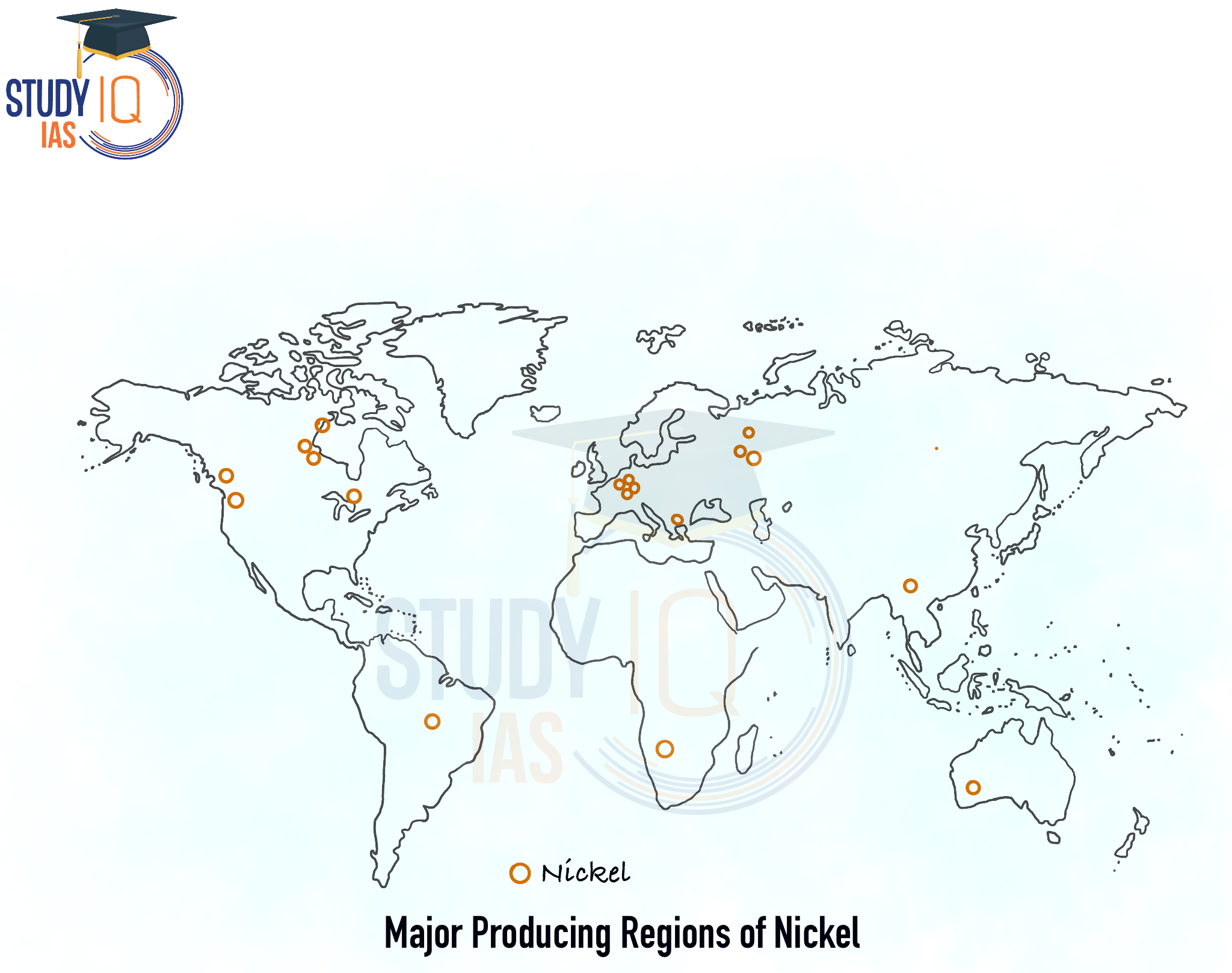Table of Contents
Context: The study, published in Nature, bypassed the traditional multistep process to extract nickel and developed a single metallurgical step conducted in one furnace.
More in News
- The traditional process includes calcination, smelting, reduction, and refining.
- Producing just one tonne of nickel from traditional process results in more than 20 tonnes of carbon dioxide emissions.
- This new method is significantly more energy-efficient (up to 18%) and drastically reduces direct carbon dioxide emissions (up to 84%) compared to traditional multi-step nickel extraction.
Nickel Ore
Pentlandite is a type of nickel ore made of nickel, iron, and sulfur. It is very hard and can withstand erosion. It is also ductile and malleable, meaning it can be shaped easily. Another source of nickel comes from polymetallic sea nodules. Most of India’s nickel resources, about 92%, are found in Odisha. The other 8% is in Jharkhand, Nagaland, and Karnataka. Nickel itself is a hard, shiny, silvery-white metal. It does not exist on its own in nature and is usually found with other metals like copper and uranium. Nickel is an important part of many alloys.
Nickel Ore Distribution in India
- The Sukinda valley in Jajapur district, Odisha, has important deposits of nickel in the form of limonite. Here, nickel appears as an oxide.
- In Jharkhand’s East Singhbhum district, nickel is found as a sulfide, along with copper.
- It has also been discovered with uranium in Jaduguda, Jharkhand.
- Additionally, nickel is found in large amounts in Karnataka, Kerala, and Rajasthan.
Nickel Distribution in the World
Indonesia and Australia have the largest nickel reserves in the world.

| Country | Regions |
| Indonesia | Sulawesi, Celebes |
| Philippines | Rio Tuba |
| Australia | Queensland and Kalgoorlie |
| Canada | Sudbury, Lynn Lake |
| CIS | Sverdlovsk and Orsk in the Urals, Kola Peninsula, Norilsk in Siberia. |
Nickel Extraction and Properties
Extraction
- Nickel is usually found with other elements like arsenic and sulfur in minerals such as nickeline, pentlandite, and millerite.
- Most nickel is extracted from laterite and magmatic sulfide sources.
- Indonesia and Australia hold the largest nickel deposits, making up 43.6% of the world’s total.
- Research shows that nickel is mainly located in the Earth’s outer and inner cores.
- Nickel is present in all soil and is released by volcanoes.
- In the environment, nickel is mostly found as oxides or sulfides and also in seafloor nodules on the ocean floor.
Properties
- Nickel ore is usually found as a sulfide or laterite and contains an average of 1-2% nickel.
- It is tough and has high tensile strength. As a result, nickel steel is used to make armoured plates and bullet jackets.
- The hardness of nickel ore varies depending on the type and specific mineral content but typically ranges from 4 to 6 on the Mohs scale.
- The specific gravity of nickel ore ranges from 2.5 to 4.5, depending on the type and mineral content.
- Some nickel ore may exhibit weak magnetic properties, depending on the mineral content.
- Nickel ore has good thermal and electrical conductivity.
- Nickel ore is not highly reactive, but can react with strong acids and oxidizing agents.
- Nickel ore can range in colour from silver to black, depending on the type and mineral content.
Uses of Nickel
- Nickel is used in many industries, from construction to everyday products.
- About 65% of nickel goes into making stainless steel, improving its strength and resistance to corrosion.
- It is found in batteries like nickel-metal hydride and rechargeable nickel-cadmium, used in devices such as laptops and power tools.
- Nickel’s malleability makes it great for wires, used in electrical wiring and cable insulation.
- It combines with iron or cobalt to form superalloys for gas turbines and jet engines, known for their strength and heat resistance.
- Common items made with nickel include power tools, camcorders, scanner radios, and guitar strings.
- Copper-nickel alloys are used in desalination plants to turn seawater into freshwater due to their corrosion resistance.
- Nickel is used as a colouring agent in cosmetics, paints, and some plastics.
- It is often used in electroplating, adding a thin layer of nickel to other metals for better appearance and durability.
- Nickel helps collect platinum group elements (PGEs) in fire assays and is useful for extracting precious metals like gold.
- Plants, animals and fungi need nickel for the functioning of Enzyme Urease.
- Eg. Fungus Cryptococcus Neofarmans use Urease to spread and Colonise
- It is used as a colouring agent in cosmetics, paints, and some plastics.
- It is used in electroplating, adding a thin layer of nickel to other metals for better appearance and durability.
- It is found in batteries like nickel-metal hydride and rechargeable nickel-cadmium, used in devices such as laptops and power tools.
Diseases caused by Nickel
- Nickel is carcinogenic. It may cause lung fibrosis, kidney and cardiovascular diseases and cancer of the respiratory tract.
| Related Articles | |
| Copper Ore | Iron Ore |
| Chromium Ore | Manganese Ore |
| Types of Resources | Cobalt Ore |
| Minerals | Energy Resources |


 Largest Desert in the World, Check Name,...
Largest Desert in the World, Check Name,...
 Places in News for UPSC 2025 for Prelims...
Places in News for UPSC 2025 for Prelims...
 Evaporative Demand: Main Drivers and its...
Evaporative Demand: Main Drivers and its...





















